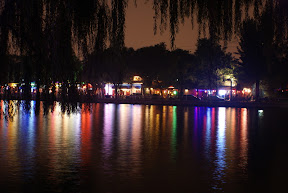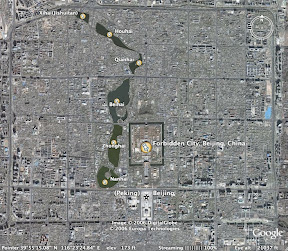 The day before yesterday I bicycled to Houhai from campus with TuotuoXP. However the weather was very very bad, no blue sky, no cloud, no fresh air, only a gray world that you can see from the photo on the right and another by TuotuoXP.
The day before yesterday I bicycled to Houhai from campus with TuotuoXP. However the weather was very very bad, no blue sky, no cloud, no fresh air, only a gray world that you can see from the photo on the right and another by TuotuoXP.After night fell, bars and coffee houses lit and became so crowded as usual.
 With water, willow trees, lights, music, etc., it's really a perfect place for friends and lovers, maybe also appropriate for losers to be alone.
With water, willow trees, lights, music, etc., it's really a perfect place for friends and lovers, maybe also appropriate for losers to be alone.We left for the Forbidden City, which was only a few blocks away. However, there was no lights that we failed to take some photos. Leave it to next time.
Some historical stuff. Hai, meaning "sea" in Chinese , sometimes refers to "big lake". There're several famous "hais" or lakes in the city of Beijing next to the Forbidden city, as shown in the map provided by Google Earth. The 2nd Ring Road is very clear, as well as the Tian'anmen square marked. From north to south, the six hais are Xihai (Jishuitan), Houhai, Qianhai, Beihai, Zhonghai and Nanhai, which literally mean west lake, back lake, front lake, north lake, middle lake and south lake, respectively.

Wikipedia gives a detailed description of the history of Beijing, and that's also a history of these hais. Over a thousand years ago Beijing was wet and abundant of rivers and lakes. In 938 the Liao Dynasty set up a secondary capital around these natural hais and named it Nanjing ("southern captial", and "Beijing" means "northern capital", funny) for the captial then was far north. In 1125 the Jurchen Jing Dynasty took over Beijing and named it Zhongdu ("central capital"). In 1215 Mongol got Beijing as its captial and later named it Dadu ("grand capital") or Cambuluc in Marco Polo's account, when Xihai (Jishuitan) then was a very important commercial port.
In 1368 the Ming dynasty founded in Nanjing (this time it's not Beijing) and in 1403 the 3rd emperor moved the capital to Beijing. The Forbidden City started to be built soon after that, also these hais were well designed as imperial gardens. The Qing Dynasty replaced the Ming Dynasty in 1644 and lasted to 1911, when Beihai, Zhonghai and Nanhai continued to be refined. The last emperor was expelled from the Forbidden City later and this palace became national museum. Even since then Nanhai and Zhonghai have been resevered as where the central govenment resides; Beihai has been open as a public park; Xihai (Jishuitan), Houhai and Qianhai, also known as Shichahai, have been good places for citizens to walk and enjoy, famous for bars and coffee houses around the lakes recent years.
3 comments:
all pix 403
I mean, from rss reader... stupid google
Next time I'll go with you if there would be next time.
Post a Comment